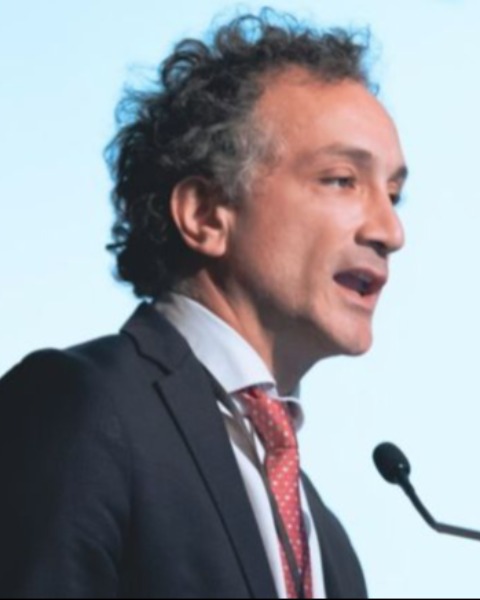Quick Fire Cases
Fontan conduit obstruction: a clinical case (QF_FR_092)

Claudia Montanaro, MD
Cardiologist - ACHD lead
UO Cardiologia del Congenito Adulto. Dipartimento di Cardiologia, Cardiochirurgia, trapianto cardio-polmonare. IRCCS Ospedale Pediatrico Bambino Gesù. Roma, Italia, Italy- ED
Emanuela Concetta D'Angelo, MD, PhD
Cardiologist
UO Cardiologia del Congenito Adulto. Dipartimento di Cardiologia, Cardiochirurgia, trapianto cardio-polmonare. IRCCS Ospedale Pediatrico Bambino Gesù. Roma, Italia, Italy - RP
Rosalinda Palmieri, MD
Cardiologist
UO Cardiologia del Congenito Adulto. Dipartimento di Cardiologia, Cardiochirurgia, trapianto cardio-polmonare. IRCCS Ospedale Pediatrico Bambino Gesù. Roma, Italia, Italy - VL
Veronica Lisignoli, MD
Cardiologist
UO Cardiologia del Congenito Adulto. Dipartimento di Cardiologia, Cardiochirurgia, trapianto cardio-polmonare. IRCCS Ospedale Pediatrico Bambino Gesù. Roma, Italia, Italy - MD
Marco Della Porta, N/A
Sonographer
UO Cardiologia del Congenito Adulto. Dipartimento di Cardiologia, Cardiochirurgia, trapianto cardio-polmonare. IRCCS Ospedale Pediatrico Bambino Gesù. Roma, Italia, Italy - GD
Giulia Di Gia, N/A
Sonographer
UO Cardiologia del Congenito Adulto. Dipartimento di Cardiologia, Cardiochirurgia, trapianto cardio-polmonare. IRCCS Ospedale Pediatrico Bambino Gesù. Roma, Italia, Italy - RI
Rossella Iuzzolino, N/A
Nurse
UO Cardiologia del Congenito Adulto. Dipartimento di Cardiologia, Cardiochirurgia, trapianto cardio-polmonare. IRCCS Ospedale Pediatrico Bambino Gesù. Roma, Italia, Italy 
- PC
Paolo Ciancarella, MD
Physician
Bambino Gesù Children’s Hospital IRCSS, Rome, Italy, Italy 
Aurelio Secinaro, MD
Consultant Cardiovascular MR/CT
Bambino Gesu’ Children’s Research Hospital, Italy- EC
Enrico Cetrano, MD
Cardiac Surgeon
UO Cardiochirurgia. Dipartimento di Cardiologia, Cardiochirurgia, trapianto cardio-polmonare. IRCCS Ospedale Pediatrico Bambino Gesù. Roma, Italia, Italy - SA
Sonia Albanese, MD
Cardiac Surgeon
UO Cardiochirurgia. Dipartimento di Cardiologia, Cardiochirurgia, trapianto cardio-polmonare. IRCCS Ospedale Pediatrico Bambino Gesù. Roma, Italia, Italy 

Claudia Montanaro, MD
Cardiologist - ACHD lead
UO Cardiologia del Congenito Adulto. Dipartimento di Cardiologia, Cardiochirurgia, trapianto cardio-polmonare. IRCCS Ospedale Pediatrico Bambino Gesù. Roma, Italia, Italy
Presenting Author(s)
Primary Author(s)
Co-Author(s)
A 25-year-old female with a Fontan Circulation was referred to our ACHD Unit for progressive dyspnea on exertion (NYHA II), bilateral peripheral oedema.and thrombocytopenia. Her cardiac background was atrioventricular septal defect with unbalanced ventricles, hypoplastic ascending aorta and persistent left superior vena cava. She underwent a complete Fontan palliation with extracardiac conduit at age of 3 years. On physical examination, blood pressure was 136/80 mmHg, resting oxygen saturation 96%, the rhythm was sinus with an heart rate of 86 bpm. On blood tests, Haemoglobin was 14.7 g/dL was with normal iron storage, platelets 67.000/mm3 with raised transaminases, GGT and INR. The abdomen ultrasound showed increased dimension of the heterogenous liver parenchyma, hypertrophy of the caudate lobe and nodular focal regenerative areas.
The trans-thoracic echocardiogram showed preserved systolic function of the single ventricle and moderate valve regurgitation. An hyperechogenic structure in the lumen of the extracardiac Fontan conduit was noted. This, together with the abnormal wave Doppler in the venous caval flows, raised the suspicion of tunnel obstruction.
Diagnostic Techniques and Their Most Important Findings:
The Cardiac Magnetic Resonance (CMR) study showed the presence of severe obstruction of the tunnel at its superior part. The 3D -SSFP post gadolinium injection allowed a better visualisation of the obstruction (Figure 1) and together with flow calculation, numerous veno-veno collaterals were identified. The Glenn's anastomosis and pulmonary branches were unobstructed.
The Cardiac Computational Tomography allowed a precise characterization of the mass obstructing the lumen of the extra-cardiac conduit which appeared severely calcific with a small central lumen and some residual circumferential flow (Figure 2). An extensive veno-venous collateral circulation between the inferior and superior caval system, bypassing the obstructed tunnel segment, was demonstrated. These features, together with the clinical assessment, confirmed the chronic nature of the obstruction. There were no signs of pulmonary embolism.
The case was urgently discussed in the Multidiciplinary Team and the patient underwent surgical extracardiac conduit replacement (Figure 3). The patient was discharged 1 week later with already an improved clinical status (no peripheral oedema, improving thrombocytopenia).
Learning Points from this Case:
- Chronic conduit sub-occlusion in a Fontan circulation is an infrequent event but should always be suspected in case of sign and symptoms of decompensation.
- CMR offers a definitive diagnosis when echocardiography is limited. CT allows characterization of calcific masses and a better temporal-spatial resolution of the veno-veno collaterals/anatomical structure, important for the pre-surgical planning.

